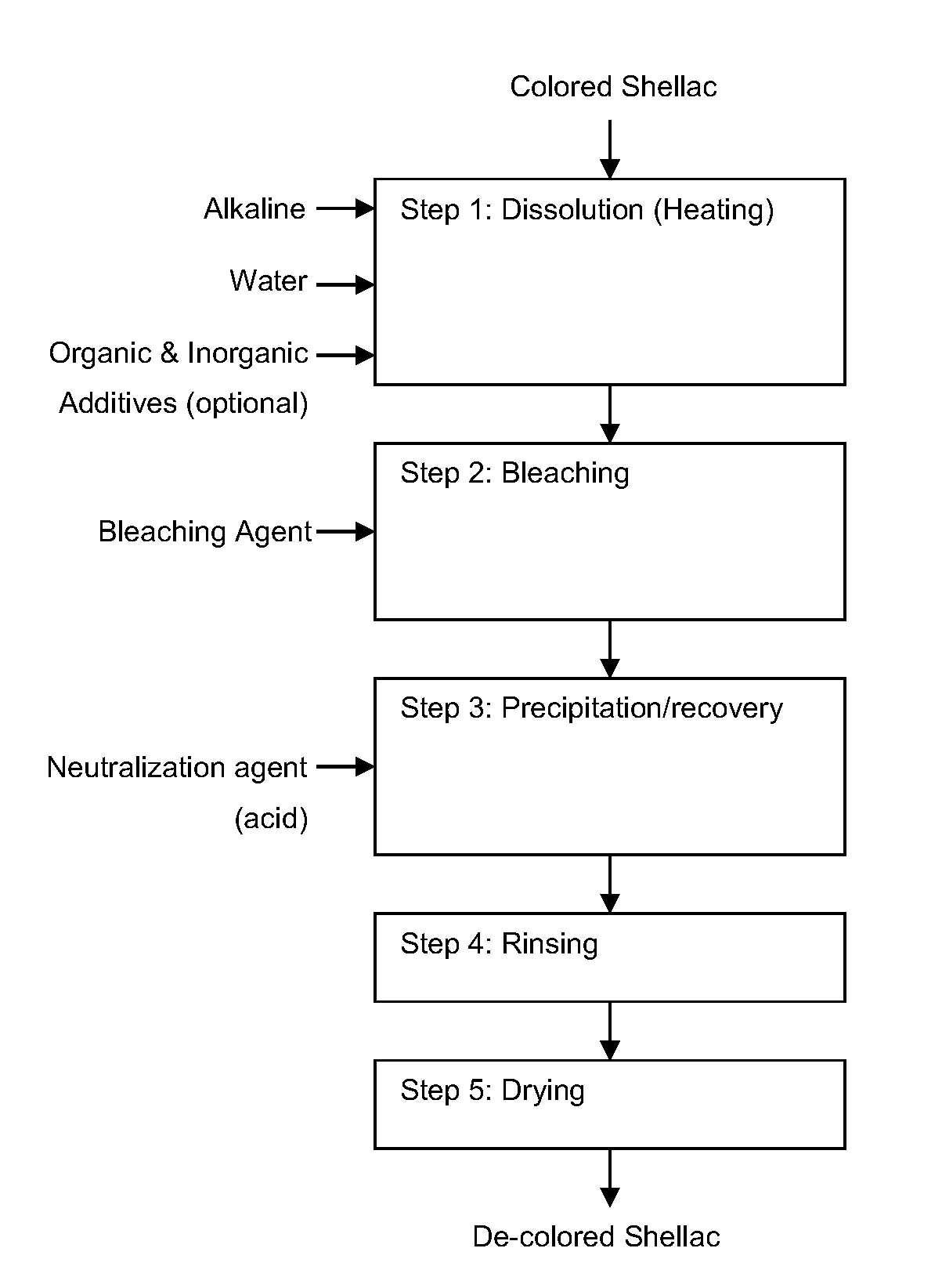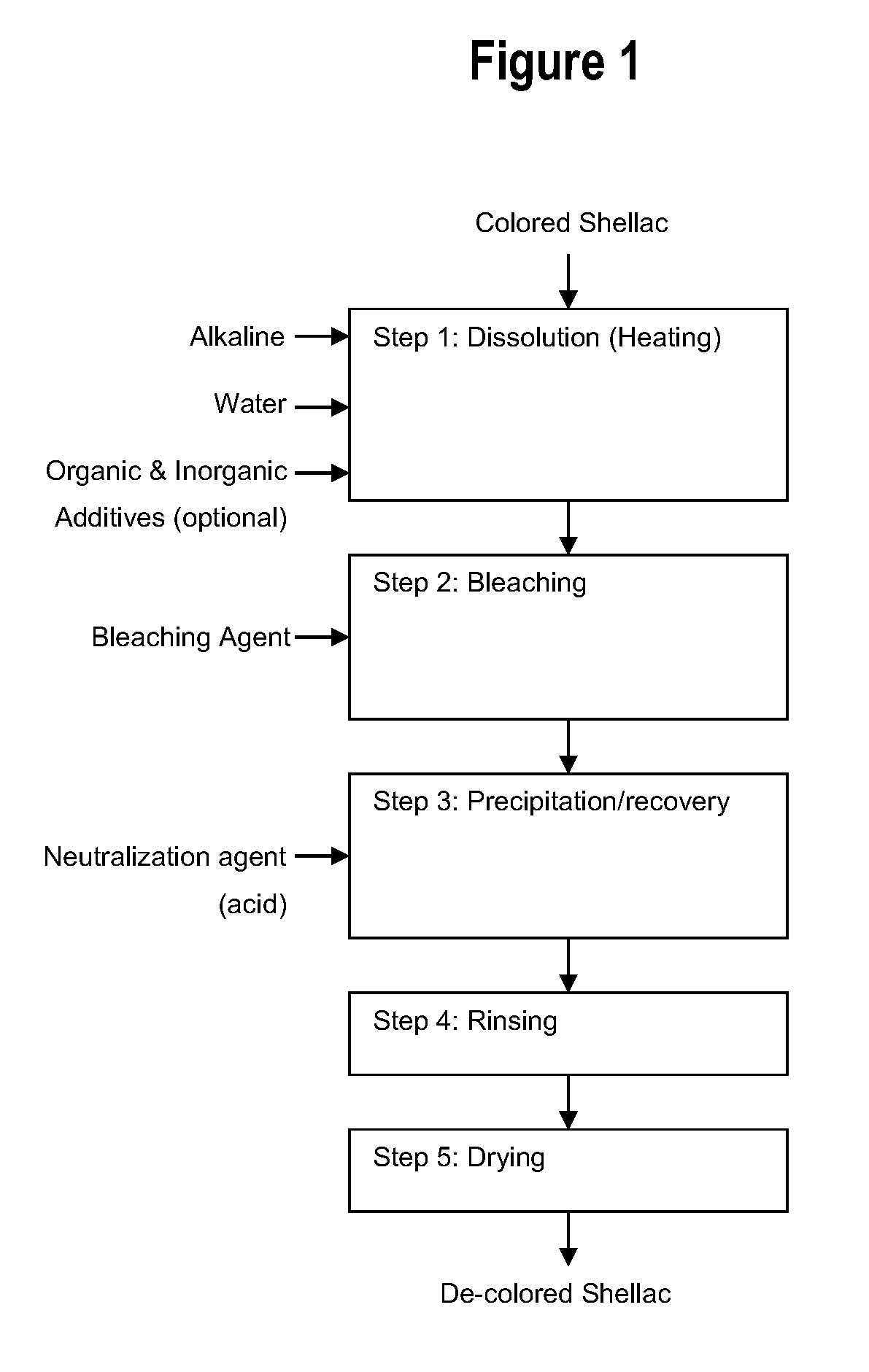Method for de-coloring shellac, de-colored shellac, compositions comprising same, and uses therefor
a shellac and shellac resin technology, applied in the field of shellac decolorization, decolorization shellac, compositions comprising same, can solve the problems of significant color remaining, unsuitability of shellac resin presence of residual color, and failure of bleaching techniques to produce shellac that is truly colorless or more decolorized
- Summary
- Abstract
- Description
- Claims
- Application Information
AI Technical Summary
Benefits of technology
Problems solved by technology
Method used
Image
Examples
example 1
Materials
[0123]The colored shellac chosen as raw material was previously bleached and de-waxed by the manufacturer. The following information is from the accompanying safety data sheet, article number 60450, named “shellac”: bleached, very light, CAS 9000-59-3; EINECS 232-549-9, color: pale yellow, sold under food grade. Although the product name includes the term “white”, the color of the shellac product is in fact pale yellow, as indicated in the data sheet. Other chemicals, unless otherwise mentioned were obtained from a standard chemical supplier such as Sigma-Aldrich.
example 2
Process of De-Coloring Shellac
[0124]As shown schematically in FIG. 1, methods of de-coloring shellac according to the present invention generally include the following main steps: Dissolution of the colored shellac used as starting material using an alkaline agent; de-colorization / bleaching of the dissolved colored shellac using a bleaching agent; precipitation / recovery of the de-colored shellac using a neutralization agent; recovery, rinsing, and drying of the de-colored shellac. An exemplary process for de-coloring shellac is described below.
[0125]In the dissolution step, 10 g of the colored shellac of Example 1 and 4 g of the alkaline agent sodium bicarbonate (NaHCO3), were weighed and transferred to a beaker. Water was added to complete to 100 g, and the contents were heated preferably to about 80° C. while stirring until the reagents completely dissolved (about 15-30 minutes). The color of the solution at this stage was light pink. In the de-colorization / bleaching step, 1 g of ...
example 3
Effect of Various Alkaline Agents
[0127]The effect of different types of alkaline agents, namely NaOH, NaHCO3, Na2CO3, and KOH were compared as described below.
[0128]In the dissolution step, 10 g of the colored shellac of Example 1 and 4 g of any one of the alkaline agents mentioned above were weighed and transferred to a beaker. Water was added to complete to 100 g, and the contents were heated preferably to about 80° C. while stirring until the reagents completely dissolved (about 15-30 minutes). In the de-colorization / bleaching step, 1 g of the bleaching agent sodium chlorite (NaClO2), was added after cooling the solution to about 30-50° C. by agitation and / or by incubation in ice water. In the precipitation step, the shellac solution was neutralized with the neutralization agent acetic acid (e.g., 60 mL of 20% w / w acetic acid / water), and a precipitate of the shellac formed. In the final step, the precipitate was recovered by filtration with a glass filter, washed to remove the sa...
PUM
| Property | Measurement | Unit |
|---|---|---|
| Temperature | aaaaa | aaaaa |
| Fraction | aaaaa | aaaaa |
| Fraction | aaaaa | aaaaa |
Abstract
Description
Claims
Application Information
 Login to View More
Login to View More - R&D
- Intellectual Property
- Life Sciences
- Materials
- Tech Scout
- Unparalleled Data Quality
- Higher Quality Content
- 60% Fewer Hallucinations
Browse by: Latest US Patents, China's latest patents, Technical Efficacy Thesaurus, Application Domain, Technology Topic, Popular Technical Reports.
© 2025 PatSnap. All rights reserved.Legal|Privacy policy|Modern Slavery Act Transparency Statement|Sitemap|About US| Contact US: help@patsnap.com



